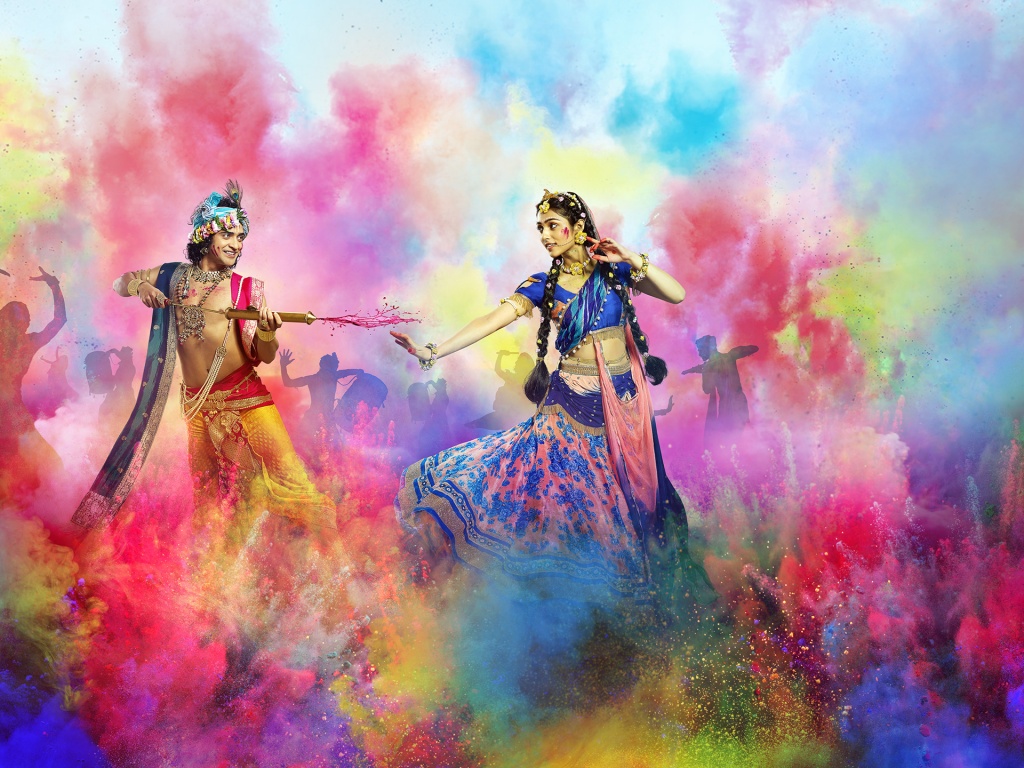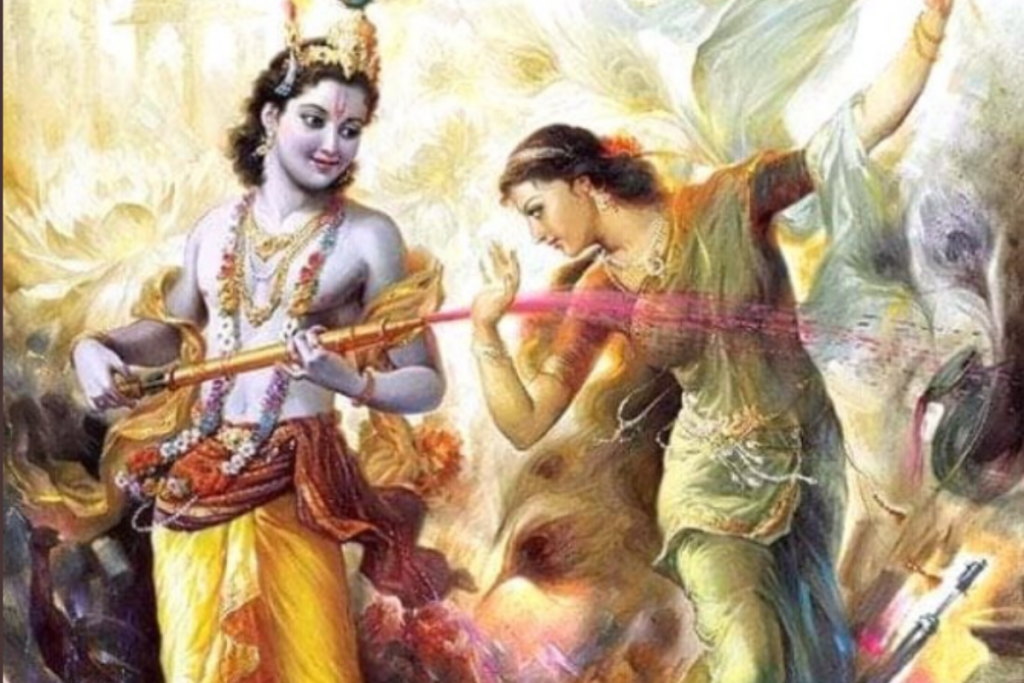Šri Hit Čaurasi,- Šri Hita Harivanšo Mahaprabhu poezijos/ maldų rinkinys. Šią knygą sudaro 84 eiliuoti tekstai. Šiame įraše dalinuosi lietuvišku 57- osios maldos “Pirmiausia, aš lenkiuosi Šri Vrindavanui!” pratham yathāmati pranau shrī-vrindāvan atiramya lietuvišku bei anglišku vertimu.
Šį meilės himną Hita Harivanšas parašė tik tik atvykęs į Vrindavaną prieš maždaug 517 metų (ta vieta vadinama Madan Ter).
Verčiau remdamasis Hari-Radhacharan das (https://sriharivansh.wordpress.com/sri-hit-chaurasi-84-songs-of-sri-harivansh-mahaprabhu/ (anglišką vertimą taip pat pridedu)) ir Pratibha Goswami (knygos: Hit Chaurasi- the 84 hymns of Divine Love) angliškais vertimais, bei sanskrito kalbos žodynu (https://sanskritdictionary.com/).
Pirmiausia, aš lenkiuosi Šri Vrindavanui! pratham yathāmati pranau shrī-vrindāvan atiramya | Šri Hit Čaurasi (57-oji malda).
pratham yathāmati pranau shrī-vrindāvan atiramya,
shrī-rādhikā kripā binu sab ke manan agamya | 1 |
Pirmiausia, aš lenkiuosi gražiausiajam Šri Vrindavanui. Be Šri Radhikos gailestingumo niekas to nesupras. (1)
“First of all, I pay respects as best as I can to Sri Vrindavan, the most beautiful.Without the mercy of Sri Radhika, it can not be understood by anyone.”
var yamunājal sīnchan dinahī sarad-basant,
vividh bhānti sumanas ke saurabh alikul mant | 2 |
Šventas Jamunos upės vanduo maitina (Vrindavano) žemę, tiek ruduo tiek ir pavasaris visuomet jaučiamas čia. Bitės (Vrindavane) apsvaigusios nuo įvairiausių gėlių kvapų. (2)
“The river Yamuna’s excellent water nourishes the land and autumn and spring are ever-present. Swarms of bees are intoxicated with the scents of many types of flowers.”
arun nūt pallav par kūjat kokil kīr,
nirtan karat sikhīkul ati ānand adhīr | 3 |
Ant medžių šakelių (raudonų lapelių) gegutės ir papūgos saldžiai gieda. Povų būriai šoka apimti didžiulės palaimos. (3)
“On red new leaves, cuckoos and parrots sing sweetly.While troops of peacocks dance overwhelmed in great happiness.”
arun – augalas gydomasis;
nūt– young, fresh, natūralus;
pallav– šakelė, pumpuras, žiedas, daigas;
kūjat– čiulba (eng.chirping), dainuoja;
kokil– gegutė;
kīr– papūga;
bahat pavan ruchi dāyak sītal-mand-sugandhu,
arun nīl, sit mukulit jahā tahā pūshan-bandhu1 | 4 |
Pučia malonus, vėsinantis, švelnus ir kvapnus vėjelis; visur žydi raudoni, mėlyni ir balti lotosai. (4)
“A pleasant breeze blows, cooling, gentle and fragrant;and red, blue and white lotuses are blooming everywhere”.
ati kamnīye birājat mandir naval nikunj,
sevat sagan prītijut din mīndhvaj-punj | 5 |
Čia labai graži ir vis kitaip nauja nikunja, kurioje džiaugsmingai tarnauja daugybė meilės dievų (kamadevų). (5)
“There lies a most attractive ever-fresh nikunja,which is always joyfully served by many Gods of Love [kamadevas].”
rasik rāsi jahā khelat shyāmāshyām kisor,
ubhay bāhu pariranjit utte unīde bhor | 6 |
Kur nuostabiausi įsimylėjėliai, jaunatviški Shyama ir Shyam (Radha ir Krišna) žaidžia. Auštant jie pabunda mieguisti, apsikabinę vienas kitą. (6)
“Where the best of lovers, that youthful Shyama Shyam play.At dawn, they awake drowsily with their arms around one another.”
kanak kapis patt sobhit subhag sānvare ang,
nīl basan kāminī urr kanchukī kasūmbhī surang | 7 |
Krišnos gražus tamsus kūnas papuoštas auksiniu audeklu, o aistringa ponia dėvi mėlyną suknelę (sarį) ir raudoną palaidinę/maikutę (kančiuki). (7)
“[His] beautiful dark limbs are decorated in golden cloth;and the passionate lady wears a blue dress along with a kasumbhi-red blouse.”
pūshan-bandhu – literally means ‘friends of the Sun’ – which refers to daytime lotuses [kamala] since theybloom during the daytime.
tāl rabāb muraj daph bājat madhur mridang,
saras ukati-gati sūchat var bansurī mukhchang | 8 |
„Skamba Karatalai (cimbolai/muzikinės lėkštės), rababai (styginiai instrumentai), mrindangos ir kiti įvairūs būgnai, o nuostabūs fleitų ir lūpinių armonikėlių/ arfų (mukhčangų) garsai prisideda prie nuostabios atmosferos kūrimo. (8)
“Cymbals, the rabab, muraja-drum and the frame-drum play along with the long-barreldrum; and the marvellous flute and mouth-harp indicate the rhythm.”
Rebab is the name of several related string instruments;
Morchang: an iron jews harp from Rajasthan (lūpinė armonikėlė/arfa);
Muraja (मुरज) is the same as Mṛdaṅga (a kind of drum);Tal– muzikinės lėkštės, cimbolai, karatalai;
dou mili chânchar gâvat gorî râg alâp,
mânas-mrig bal bedhat bhrukuti dhanush drig châp | 9 |
Jie (Radha ir Krišna) kartu dainuoja (tą pačią) pavasarinę dainą, savo balsais prisderindami prie gauri ragos. Jų žvilgsniai meilės strėlėmis perveria vienas kito širdis. (9)
“The two sing a springtime song together, tuning their voices to the Gauri – raga.The bows of their eyebrows and the arrows of their eyes [their glances] forcibly pierce thedeer of their minds!”
dou kar târinu patkat latkat itt utt jât,
ho-ho-horî bolat ati ânand kulkât | 10 |
Plodami rankomis ir siūbuodami iš laimės jie klaidžioja šen bei ten. Jausdami didelę palaimą, jie šaukia ho-ho-hori ir juokiasi. (10)
“Clapping their hands and swaying [due to the feeling of intense happiness], they wanderhere and there. Feeling great bliss, they call out Ho-ho-hori!.”
rasik lâl par melat kâmini bandan dhûri,
piya pichkârinu cchirkat taki-taki kum-kum pûri | 11 |
Aistringa dama ištepa rasišką savo mylimąjį spalvotais milteliais. Jos mylimasis (Krišna) užpildo vandens švirkštą raudonais dažais ir purškia į savo mylimąją (Radhą). (11)
“The passionate lady smears dry coloured powder over her Lover Sri Lalju;and he sprinkles her with the kum-kum powder from his water-syringe again and again.”
kabahu-kabahu chandan taru nirmit taral hindol,
chadhi dou jan jhûlat phûlat karat kalol | 12 |
Būna, kad sakės pakabiną judančias sūpynes ant sandalmedžio. Įsimylėjėliai susižavėję supasi ir juokiasi. Jiems labai patinka supynių ir holi festivaliai! (12)
“Sometimes a moving swing is set up on a sandalwood tree;the two climb aboard and swing, feel thrilled and have fun.”
var hindol jhakoran kâmini adhik darât,
pulaki-pulaki vepath ang prîtam urr laptât | 13 |
Kartais Radharanė išsigąsta supimosi! Jausdama jaudulį Ji tvirtai apkabina Mylimąjį. (13)
“The passionate lady feels very afraid by the swift movements of the wonderful swing! Feeling a thrill, she wraps her trembling limbs around her Beloved’s chest.”
hit-chintak nij cherinu urr ânand na samât,
nirakhi nipat nainan sukh trin taurat bali jât | 14 |
Nuolat gero linkinčių sakių (palydovių) širdys prisipildo laimės, kai mato Radhą ir Krišną apsikabinusius. Atrodo, jog tarnaičių džiaugsmas neturi jokių ribų. (14)
“Their well-wishing maidservants’ hearts overflow with happiness and realising thepleasure of the eyes [in seeing them], they make a protective gesture and dedicate theirlives [to the lovely couple].”
ati udâr vivi sundar surat sûr sukumâr,
(jay-shrî) hit harivansh karo din dou achal bihâr | 15 |
Abu įsimylėję herojai yra labai patrauklūs. Hitas Harivanshas sako, tegul ši nuostabi (jausmingų kovotojų/aktorių) porelė amžinai dalyvauja meilės žaidimuose. (15)
“These two tender amorous heroes are both very generous and attractive.Hit Harivansh says, may the pair be absorbed in their loving plays forever.”
Daugiau Šri Harivanšo poezijos (išverstos lietuviškai) galite rasti:
https://evaldas-palskys.lt/ciategory/vertimai/sri-hit-caurasi/
Jay Vrindavan!
Paaiškinimai:
Murajâ (मुरजा) refers to a “drum type of instrument”, according to the Viṣṇudharmottarapurâṇa, an ancient Sanskrit text which (being encyclopedic in nature) deals with a variety of cultural topics such as arts, architecture, music, grammar and astronomy.— In the Viṣṇudharmottarapurâṇa, the playing of murajâ i.e., drum type of instrument is nicely explained. It is said here that to play these kinds of instruments, sixteen syllables are needed. These syllables are- ka, kha, ga, gha, ṭa, ṭha, ḍa, ḍha, ta, tha, da, dha, ya, ra, la and ha. These syllables are played on a drum kind of instruments with proper hand strokes.
The rebab (Arabic: ربابة, rabāba, variously spelled rebap, rubob, rebeb, rababa, rabeba, robab, rubab, rebob, etc) is the name of several related string instruments that independently spread via Islamic trading routes over much of North Africa, Southeast Asia, the Middle East, and parts of Europe.[1] The instrument is typically bowed, but is sometimes plucked. It is one of the earliest known bowed instruments, named no later than the 8th century, and is the parent of many bowed and stringed instruments.
Arundhati – medicininis augalas arba arundhatī – jaunikis/sužadėtinė, kuri vadovaujasi santuokos tobulumo pavyzdžiu; personified as the wife of one of its seven chief star;

















